MyHimalayasimpressions from |
|
|||||||
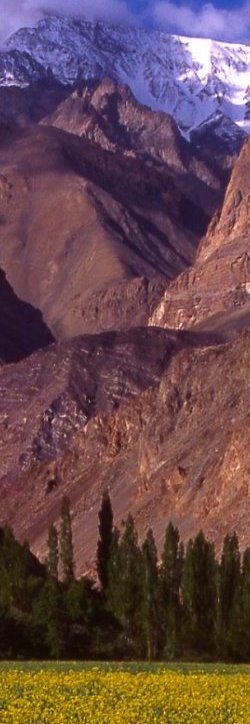
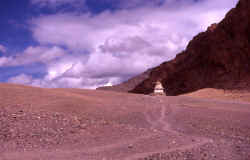
Chorten after Hemis indicates the way.
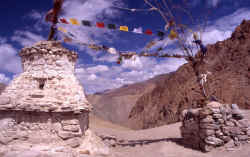
From top of the unnamed pass, the next (and final pass of Lago La) is already visible.
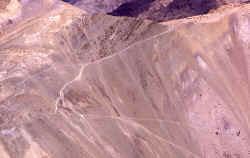
Tourists on their way up to Lago La, the climb is actually shorter and easier than it looks from a distance.
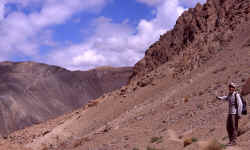
It's usually easy to make out the trails, this one leading up to the last one before it goes gently downhill to Ang.
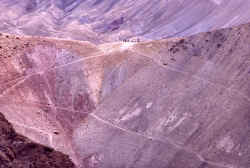
Looking back from Lago La towards Hemis and the unnamed pass which I crossed just half an hour earlier.
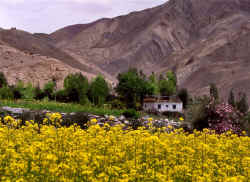
After the two hour walk in barren landscape, the lush valley of Ang seems like an oasis.
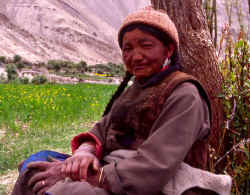
Local farmer in Ang who takes a short break from work in the fields.
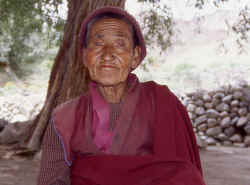
A nun from Rizong nunnery is visiting friends in Ang.
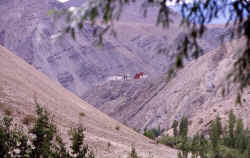
The gompa of Timosgang comes in sight first, the village lies at the bottom of the valley between fields and trees of apricot, apples and walnut.
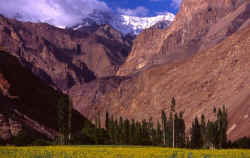
Wide fields of Temisgon are a sign of its prosperity.
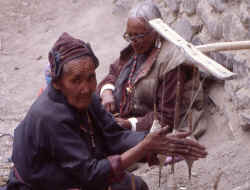
The young generation uses motorbikes and cars, their grandparents still live very traditionally - spinning wool is a traditional "past time".
Likir: Temisgoan - Leh
Hemis Shakpachen - Timosgang - Leh
Hemis Shukpachu – Ang – Timosgang (Day 5)
The song of several birds in the garden wakes me up early. Breakfast, chapatis with spicy green vegetables, is a delicious start for a short walking day. The map and description leave a little bit too much of interpretation, but I meet some kids on the outskirt and an old couple that point me into the right direction. The trail continues westwards, first through a grassy meadow and then I reach a hillside with many chortens to my left. I continue on the trail passing a forest of gnarly cedars (or large junipers) on my right. It is probably those trees that gave the village its name, xxx.
The village appears in local history books because it could have cost Jamyang Namgyal his kingdom. Ruling Ladakh in the early 17th century, he started the building of roads and water channels to increase agriculture. One of the workers was digging an irrigation near Hemis Shakpachen, when a man-sized lizard crawled out of a cave. He killed it with his spade, not knowing that it was a naga, an earth-spirit. As a punishment, the king fell sick, and none of his lamas or doctors could help. Therefore the famous lama Dhanmatsang from the Bringungpa sect, who was meditating in a cave near Mount Kailash, was invited to drive the evil spirit away. The lama succeeded, and the king offered his kingdom as a reward. The lama declined, but they agreed that the king should initiate the construction of several monasteries. Additionally, the king handed over Lamayuru monastery to the lama, and decided that the monastery is exempt from taxes and has its own jurisdiction. Criminals who managed to make it to Lamayuru were basically free. Lamayuru soon got the name Tharpa Ling, meaning Place of freedom. I’ve come to know about the lizard story only at home, but it would be interesting to see if people still remember the place of the lizard’s cave.
The cloud cover has dissolved, and the sun increases the colours of the splendid scenery: the two passes (one from Yangthang, the other from Rizong) that lead to this fertile valley stand out against the sky, the green fields contrast sharply with ochre hills and the white-washed houses fit nicely in. A last view back reveals the pass I descended yesterday and the village with its green fields. Ahead of me lies desert, and two trails. One goes a little to the left, the other one continues straight. To the south are gently curved hills, to the right red crags. Half an hour outside the village the trail branches, I continue straight and soon see a lonely white-washed chorten on the horizon. The view from there reveals a deep canyon in bizarre colours, each hill featuring his own tones. Some are grey, others white, red, yellow, and even green. „Just across“ the valley, a zig zag trail climbs to another pass, Lago La, 3'750 m. Tiny dots are moving up there like ants, probably the German group. To the south lies the dark Zanskar range whose black flanks are covered by snow. I take a break at the chorten, rest and enjoy the views.
A few cows are on the hills, I wonder what they possibly feed on. They cannot give a lot of milk, thus the more I appreciate that also this morning I was given a large chunk of fine tasting fresh butter was served. I just realize now what is most stunning about Ladakh – it is not the mountains, it is not the monasteries, it is not the spectacular scenery with its contrasts – it really is the people who make this such a fascinating place. Hospitality can be found elsewhere too, but this kind of sincere generosity towards a stranger is something I’ve never experienced before. It leaves me speechless, and is a very humbling experience. Somehow it feels strange because all I can do for a return is being appreciative, attentative and respectful. My thoughts wander around that during the half hour walk to the foot of the pass.
It’s steep and precipitous, but not as long of a climb as it looked like. A small path looks as if chiseled in the rock face, and winds itself up the slope. A refreshingly cool wind makes the prayerflags flatter on top of the pass. Looking back, even the pass from Yangtang to Hemis (Sarmanchen La) is visible. Another group from Hemis has just arrived at the chorten, their pack horses descent rapidly. From here to Ang takes about an hour, the trail goes down into the gully. I continue on a little path that goes along the crest for a few minutes to get views from Zanskar range. The trail continues along the ridge and I assume it goes to Temesgam, but I don’t want to try it out, and get back to the main trail that goes gently down in a westerly direction. The trail descends between ochre and red hills, the melting snow has washed the slopes off and they are completely bare. After half an hour the first white building appears, one of the houses of Ang.
The desert ends abruptly: yellow fields are spread over a large area, poplars and large willow trees grow along the Dangdong Kola. Aimlessly, I wander through the fields of barley and yellow flowers, enjoying the freedom of travelling alone and having plenty of time. An old woman is working in a field, picking some special leaves of grass. She says it’s tsa (which means grass) and I assume it’s animal fodder for winter days, but I’m not sure. There is a monastery she says and points to a slightly elevated house, but it’s locked and finding the key keeper will probably be difficult. So I continue downstream along the creek.
Between willow trees are a few parachute tents: places to rest, get a tea and maybe even some food. Three old women wave and I change my mind and hop on some boulders over the creek. It’s a funny company, the 30 year old owner, her mother and her grandmother run the „restaurant“ which seems to be frequented by locals more than by tourists. Two nuns from the nunnery below Rizong are chatting with them. They have the salted tea, chang (barley beer), soft drinks and are in a upbeat xxx mood. I just have a black tea, but start to feel hungry and since I probably won’t have such a great company again, order my lunch. My basic Tibetan isn’t good enough to follow their conversation (even if it hadn’t been in their Ladahi dialect), but manage to have a little small-talk. Ten minutes later the horsemen I saw descending the xxx pass stop for a quick break: they have some chang and tsampa, the barley flour. Words and laughter are flying back and forth, an outburst of joy resides for fifteen minutes. Grandmother even starts to dance with the caravan leader. After the short break they continue, and it gets quiet again. The women are now quite insistent and poses for some pictures, take a resolute stand and insist that I don’t take a portrait but vertical head-to-toe shot. I cannot really argue against that. That’s remarkable about the Ladakhi people, they are not subserviently nice and friendly but down to earth and very solid, willing and able to get their point across without being rude.
I’m ready to leave, prepare 30 rupees for tea and soup, but she returns 10 rupees saying „you didn’t have milk or sugar in your tea, so it wasn’t tea really and you shouldn’t pay for it“.
The road which connects Temisgoan to Leh has recently been extended to Ang. With some climbing I find a trail next to the road along the gurgling irrigation channel and avoid the road. The village is large, and the houses spread from the start of the valley all the down down to the Indus river. It takes me a long time to get to „Timosgan downtown“ where I can do some shopping and get mineral water. Finding a guesthouse is more difficult than I assumed, there’s only one sign and they only offer a campsite. I ask a kid about guesthouses and she takes me to a neighbour who has an empty room. It’s below the monastery and overlooks some fields, apricot, walnut and apple trees, luxurious trees for the farmers. It’ still well above 3'000 meters here.
The old women of town meet in front of the house. Two of them are spinning wool with an ingenious construction which allows them to handle five spindles at once. The other women turn their prayerwheels, seemingly being able to mutter the „o mani pade hum“ at the same time as having a conversation. Old men seem to be a minority in Ladakh.
The houses here are much larger than in any of the previous villages, some of the households own motorbikes and one even has a car. At first the road and vehicles come as a culture shock but then again it’s still a very traditional, tranquil Ladakhi town. Nevertheless, staying in Ang would have been more idyllic.
Below the large prayer wheel there a good views into a large sidevalley that is also very fertile. No wonder this was once the capital of „lower Ladakh“, together with Basgo. The fort lies in ruins, only two small parts of the towers remain standing on a commanding position. The town is famous for it gave the name to the „Treaty of Temisgam“, in 1864. It declared the relations (trade- and religiouswise) between Ladakh and Tibet, after Ladakh sided with Bhutan on a religious dispute with Lhasa. It was probably not a philosphical argument but rather a way of demonstrating against being bullied around by the powerful Tibetan empire. Lhasa reacted, sent a powerful army to Ladakh and was held up by a Muslim army from Kashmir. Ladakh lost its autonomy, the king had to convert to Islam, and all trade of pashm was exclusively to be done by Kashmiri merchants. However, the religious life of normal people doesn’t seem to have changed, most of them remained Buddhists.
I do not visit the monastery, and walk around the lower part of town instead. The yellow flowers, tall poplars and sheer cliffs is a memorable sight. From my window I can see on neighbours' roofs and have conversation with some small children, their English is very good considering they’re only in class 2. I’m surprised to see no solar panels, but there’s a generator further down which generates enough electricity for the entire village.
Tingmosgang is nice but to really enjoy a tranquil day I should have stayed in Ang. Continuing further west to Khalsi would be an option, but I’m afraid it would be an unsuitable end for fantastic three days:
I’ve seen a scenery of Ladakh which I haven’t known before – Zanskar and Tso Moriri where I’ve been before are either more confined or much more open. Also the fertility of western Ladakh is stunning. The people I have met were outstanding. Travelling in a group fine, but when you’re on your own you’re forced to get in touch with local people, and I will remember this interaction longer than the views of the fantastic scenery.
Timosgang – Leh (Day 6)
Though the family I stayed with was nice, Timosgang is not such a lovely village as the others and I will take the bus back today. I get up early and stroll through the fields on this beautiful morning. The sun drives the night’s chill away quickly, turns the barley fields into a soft green and the yellow fields into a bright contrast to the dark blue sky. The rugged layers of the mountains are accentuated by the shadows thrown by the sun. I wait for the bus near the big prayer wheel, and there are some free seats. A colourful crowd is inside the bus: farmers, kids, women on their way to Leh. It’s a bit cramped and the stereo is blurring high-pitched (Kashmiri?) folk pop songs. But it’s not as uncomfortable as I feared, and I fully enjoy the ride.
The contrast between habitation and desert is stunning; then after some twists in the road we’re at the Indus valley. The grey slow moving river comes as a surprise, it is not the fast flowing gurgling river I would have expected but then again it has already made a way of 150 km since its start at Mount Kailash, and has been tamed since then. Though we haven’t lost much altitude, the agricultural season is a few weeks ahead. Wheat is already a foot high and the ears move in the gentle breeze. The road leads eastwards but doesn’t follow the river all the way, in steep curves it sometimes moves away from it and joins it later.
After a long ride on a plateau the wide Indus valley near Leh appears on the horizon. The ride was much less strenuous than assumed, and though I’m not stingy I’d have to think twice if I really want to pay the ten-fold price for a jeep the next time. Of course the taxi allows for frequent stops and little excursions. Since the bus took only 4 hours I have the entire rest of the day to relax in the garden of Tongspon guesthouse.
|
Summary Part 4:
I leave Hemis behind and continue westwards. In the dry scenery after the village, the chortens and trail are easy to see and to make out the route. The path winds itself up to the last pass, from there it is another hour of downhill through colourful scree slopes. Abruptly the desert ends and another colourful village begins. Betwen green and yellow fields lie the houses of Ang. Descending in the same valley, I soon reach the old capital of lower Ladakh - Temisgom. After spending a night in a guesthouse, I take the daily bus to Leh. |